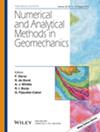元素试验中正常固结土的封闭形式低塑性溶液
IF 3.4
2区 工程技术
Q2 ENGINEERING, GEOLOGICAL
International Journal for Numerical and Analytical Methods in Geomechanics
Pub Date : 2025-05-06
DOI:10.1002/nag.3994
引用次数: 0
摘要
发育不全理论在岩土力学领域的本构建模和数值模拟中得到了广泛的应用。然而,缺乏一个分析基准的数值模拟纳入发育不良模型仍然是一个显着的差距。本研究通过提供明确的破坏准则和材料参数公式,重新审视了Wu等人提出的正常固结土的基本发育不良模型。此外,在三种元素试验中推导出正常固结土的闭型欠塑性解:土径计试验、简单剪切试验和真三轴试验。通过将解析结果与数值积分和岩土试验数据进行比较,对解进行了评价。此外,本文还推导了一个估算静土压力系数的新公式,并与广泛采用的Jaky方程进行了比较。我们的解决方案不仅提供了对发育不良模型增强的见解,而且还作为数值实现的稳健基准。本文章由计算机程序翻译,如有差异,请以英文原文为准。
Closed‐Form Hypoplastic Solutions for Normally Consolidated Soil in Element Tests
The hypoplastic theory has gained significant attraction in the geomechanics community for constitutive modeling and numerical simulation. However, the absence of an analytical benchmark for numerical simulations incorporating the hypoplastic model remains a notable gap. This study revisits the basic hypoplastic model for normally consolidated soil, as proposed by Wu et al., by providing explicit formulations of the failure criterion and material parameters. Furthermore, closed‐form hypoplastic solutions are derived for normally consolidated soil in three elemental tests: oedometer, simple shear and true triaxial tests. The solutions are assessed by comparing the analytical results with numerical integration and geotechnical test data. Additionally, a novel formula for estimating the at‐rest earth pressure coefficient is derived, and compared to the widely adopted Jaky equation. Our solutions not only provide insights into hypoplastic model enhancement but also serve as robust benchmarks for numerical implementations.
求助全文
通过发布文献求助,成功后即可免费获取论文全文。
去求助
来源期刊
CiteScore
6.40
自引率
12.50%
发文量
160
审稿时长
9 months
期刊介绍:
The journal welcomes manuscripts that substantially contribute to the understanding of the complex mechanical behaviour of geomaterials (soils, rocks, concrete, ice, snow, and powders), through innovative experimental techniques, and/or through the development of novel numerical or hybrid experimental/numerical modelling concepts in geomechanics. Topics of interest include instabilities and localization, interface and surface phenomena, fracture and failure, multi-physics and other time-dependent phenomena, micromechanics and multi-scale methods, and inverse analysis and stochastic methods. Papers related to energy and environmental issues are particularly welcome. The illustration of the proposed methods and techniques to engineering problems is encouraged. However, manuscripts dealing with applications of existing methods, or proposing incremental improvements to existing methods – in particular marginal extensions of existing analytical solutions or numerical methods – will not be considered for review.

 求助内容:
求助内容: 应助结果提醒方式:
应助结果提醒方式:


